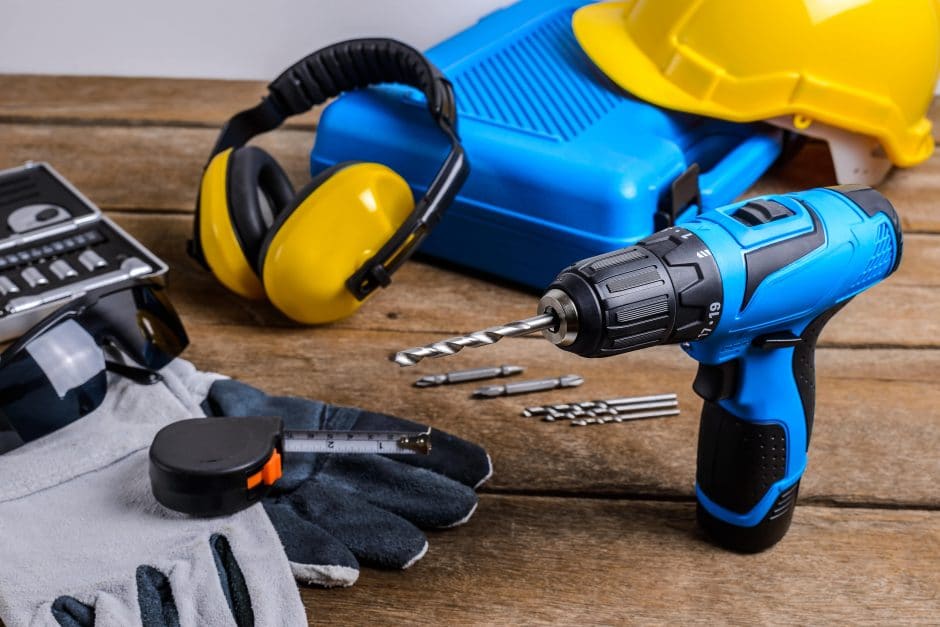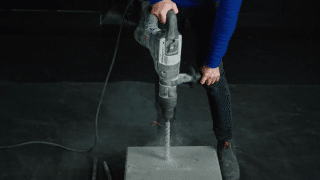
Power tools are the easiest and most efficient way for DIYers and pros to accomplish most jobs. When used correctly, they’re safer and more accurate than hand tools. When used without the proper safety techniques, however, power tools can be very dangerous. The following essential tips for power tool safety will help you stay safe while operating these efficient, accurate, and powerful tools.
What is a power tool?
A power tool is any tool that utilizes a fuel source in addition to manual labor. This definition would include tools that plug into the wall, tools that run on batteries, and tools that run on liquid or compressed gas. Technically, tools that run on compressed air are pneumatic, but the rules in this guide will still apply.
Some popular power tools include:
- Power drill drivers
- Circular saws
- Miter saws
- Table saws
- Reciprocating saws
- Impact drivers and wrenches
- Air compressors and the tools they power
- Sanders
- Angle grinders
In general, all of these tools can be very safe when used properly. Some even have additional safety guards and features to keep the user safe. In addition to those features, the following safety tips will help keep yourself and others safe from harm while accomplishing a variety of tasks.
12 Essential tips for power tool safety
Do your best to learn and put the following tips into practice. Ultimately, any tool, regardless of the size or power source, is capable of hurting someone, so it’s important to be as safe as possible when using them.
1. Always wear the appropriate safety gear
It’s always important to wear some type of safety gear when working with power tools. Usually, a pair of safety glasses is the minimum. It might also be important to wear a dust mask and hearing protection, depending on the task. Also, don’t wear loose-fitting clothing as it could tangle in the tool and cause injury.
2. Read the instructions in the user manual
There is no better guide to using a particular tool safely than the instructions in the user manual. This guide will explain how to maintain, lubricate, and change accessories, operate the tool, and even point out some unsafe methods. It might not be riveting content, but it’s always a must-read.
3. Always carry a tool by the grip
Anytime you’re transporting a tool, you should be carrying it by the grip. Carrying a tool by the cord or hose can cause damage, and it can lessen its lifespan. Loose cords or damaged hoses can be dangerous. Be sure to keep fingers off the switch button while carrying a plugged-in tool.
4. Maintain tools with care
As with any tool, maintaining your power tools correctly is important. They need to be relatively clean, and the safety devices should work properly. The grips should be clean of oil and sharp edges on blades should be covered with guards and removed completely during storage.
5. Inspect tools before use
Maintenance is important, but when it comes to staying safe, each tool should undergo a quick inspection before use. Users should check the safety features, cords, hoses, blades, bearings, and overall condition of the tool. Damaged tools should not see use—replace them or take them to a repair shop.
6. Never remove or alter the safety guards
The safety guards covering blades on circular saws, miters saws, or table saws are there to prevent the user from accidentally touching a spinning blade, so they need to stay in place. Also, avoid accidental starting by keeping the two-stage safety triggers functional.
7. Work on stable surfaces
Using a power tool on an unstable surface is a recipe for disaster. Trying to cut lumber while balancing on a sawhorse or cutting pipes as they lay across a bucket can result in getting hurt. Use a portable workbench or a stand meant specifically for the tool.
Power tools are the easiest and most efficient way for DIYers and pros to accomplish most jobs. When used correctly, they’re safer and more accurate than hand tools. When used without the proper safety techniques, however, power tools can be very dangerous. The following essential tips for power tool safety will help you stay safe while operating these efficient, accurate, and powerful tools.
What is a power tool?
A power tool is any tool that utilizes a fuel source in addition to manual labor. This definition would include tools that plug into the wall, tools that run on batteries, and tools that run on liquid or compressed gas. Technically, tools that run on compressed air are pneumatic, but the rules in this guide will still apply.
Some popular power tools include:
- Power drill drivers
- Circular saws
- Miter saws
- Table saws
- Reciprocating saws
- Impact drivers and wrenches
- Air compressors and the tools they power
- Sanders
- Angle grinders
In general, all of these tools can be very safe when used properly. Some even have additional safety guards and features to keep the user safe. In addition to those features, the following safety tips will help keep yourself and others safe from harm while accomplishing a variety of tasks.
12 Essential tips for power tool safety
Do your best to learn and put the following tips into practice. Ultimately, any tool, regardless of the size or power source, is capable of hurting someone, so it’s important to be as safe as possible when using them.
1. Always wear the appropriate safety gear
It’s always important to wear some type of safety gear when working with power tools. Usually, a pair of safety glasses is the minimum. It might also be important to wear a dust mask and hearing protection, depending on the task. Also, don’t wear loose-fitting clothing as it could tangle in the tool and cause injury.
2. Read the instructions in the user manual
There is no better guide to using a particular tool safely than the instructions in the user manual. This guide will explain how to maintain, lubricate, and change accessories, operate the tool, and even point out some unsafe methods. It might not be riveting content, but it’s always a must-read.
3. Always carry a tool by the grip
Anytime you’re transporting a tool, you should be carrying it by the grip. Carrying a tool by the cord or hose can cause damage, and it can lessen its lifespan. Loose cords or damaged hoses can be dangerous. Be sure to keep fingers off the switch button while carrying a plugged-in tool.
4. Maintain tools with care
As with any tool, maintaining your power tools correctly is important. They need to be relatively clean, and the safety devices should work properly. The grips should be clean of oil and sharp edges on blades should be covered with guards and removed completely during storage.
5. Inspect tools before use
Maintenance is important, but when it comes to staying safe, each tool should undergo a quick inspection before use. Users should check the safety features, cords, hoses, blades, bearings, and overall condition of the tool. Damaged tools should not see use—replace them or take them to a repair shop.
6. Never remove or alter the safety guards
The safety guards covering blades on circular saws, miters saws, or table saws are there to prevent the user from accidentally touching a spinning blade, so they need to stay in place. Also, avoid accidental starting by keeping the two-stage safety triggers functional.
7. Work on stable surfaces
Using a power tool on an unstable surface is a recipe for disaster. Trying to cut lumber while balancing on a sawhorse or cutting pipes as they lay across a bucket can result in getting hurt. Use a portable workbench or a stand meant specifically for the tool.
8. Be sure the work area is clear of others
Many DIYers have little helpers or furry shop buddies that like to hang out, but that’s not always safe around power tools. When using power tools, it’s best to ensure that everyone is clear from the work area. Things happen quickly when working with power tools so it’s better to keep everyone at a safe distance from the work.
9. Unplug power tools when lubricating or changing accessories
Whenever a bit of maintenance or sharpening occurs, the tool should be unplugged. For battery tools, simply remove the battery from the tool. This will avoid accidental starting and prevent the user from getting injured.
10. Maintain a safe grip on the tool and workpiece
There are ways to hold power tools and workpieces properly. Most manuals require the user to hold fingers in a closed grip, or at least with the user’s thumb held in. With a bit of practice, this grip will keep the user’s fingers away from the blade while also allowing them to hold the workpiece in place safely and securely.
11. Keep the floor clear of cords and hoses
Stumbling, slipping, or tripping over cords and hoses on a shop or job site floor is a serious risk associated with power tools. Instead of taking an accidental fall, be sure to keep the floor clear. Route the cords and hoses around the space, or utilize retractable reels for cord and hose management.
12. Only use sharp blades, bits, and cutters
Regardless of whether it’s a hand tool or a power tool, sharp means safe. Dull blades, bits, and cutting edges require the user to apply more force, which can easily result in a bit breaking and sailing through the air or a blade jamming and kicking the saw back at the user. If accessories such as blades and bits are sharp, they require little force, allowing the user to focus on the task at hand.
MT Copeland offers video-based online classes that give you a foundation in construction fundamentals with real-world applications, like plumbing basics. Classes include professionally produced videos taught by practicing craftspeople, and supplementary downloads like quizzes, blueprints, and other materials to help you master the skills.

